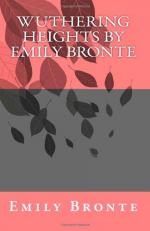|
This section contains 1,700 words (approx. 6 pages at 300 words per page) |

|
Characterization in Wuthering Heights
Summary: Explores Emily Bronte's use of characterization in her novel Wuthering Heights. Describes how Bronte uses her characters in their incongruous surroundings to exemplify her concerns of the strict social code which she herself was expected to abide by, whilst remaining true to the principles she considered most important. Analyzes the themes of controversy and paradox.
Wuthering Heights deals with the very nature of controversy and paradox. The novel expresses deep criticisms of social conventions, and Brontë uses her characters in their incongruous surroundings to exemplify her concerns of the strict social code which she herself was expected to abide by, whilst remaining true to the principles she considered most important. Wuthering Heights challenges orthodoxy with heterodoxy, of which destruction and chaos triumph over social pretensions.
The most undeniably constant difference of aesthetics and values that is presented to us is the juxtaposition of Thrushcross Grange and Wuthering Heights, initially personified by Lockwood and Heathcliff, `a dark skinned gypsy', respectively. Lockwood reckoned that he had acted so coldly to the requited affections of the `real goddess' that was his love, she `persuaded her mamma to decamp'. However, he discovers that relative to Heathcliff, he finds himself extremely sociable, where Heathcliff treats his visitor with...
|
This section contains 1,700 words (approx. 6 pages at 300 words per page) |

|


